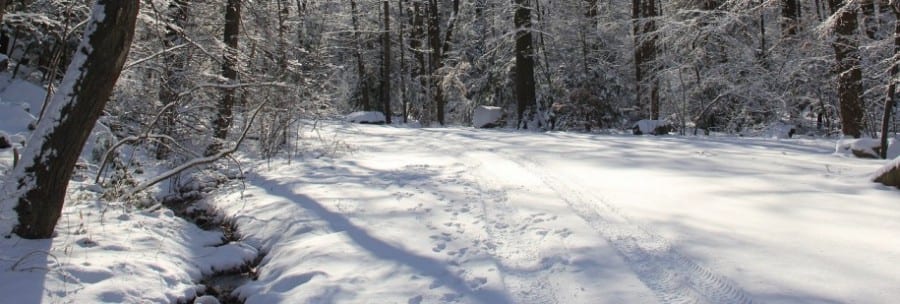Forest conditions can vary greatly during the winter months and it is up to you to hike smart! This issue of the Forest in Winter will feature helpful tips about winter hiking and recreation in Black Rock Forest.
Snow, ice, and freezing temperatures make hiking more beautiful, but also potentially more dangerous. Being a prepared hiker can make all the difference when the conditions are less than ideal during the winter months. We recommend a quality pair of hiking boots fitted with micro-spikes, snowshoes, or other traction gear on snow covered trails – especially in high traffic areas such as Sibyl’s Path where ice can build up. The varying temperatures we experience in the Hudson Valley create the possibility for ice on many trails throughout the Forest, despite the lack of snow cover at lower elevations. It is always best to come prepared with the right traction gear for your hike, even if you think it might not be needed. We recommend taking a backpack along on your hikes to carry extra layers, traction gear and extra water. Remember to dress in layers and a bright outer layer is always a good idea, no matter the time of year.
One of the most overlooked parts of your hike is planning ahead. We cannot stress enough how important it is to plan your hikes ahead of time to ensure that you get the most out of your time in the Forest. All too often we see people arrive with an expectation but are quickly disappointed because they failed to do their homework. It is always a great idea to check out our website, download a copy of the trail map, plan your route, and call ahead with any questions before arriving. Winter conditions may also affect parking availability at different entrances to the Forest so be sure to check the status before you arrive. We recommend getting your information directly from the source, not from third party websites or word of mouth from friends or social media. These factors apply to any of your hiking destinations, not just BRF, so be sure to practice them no matter where you are hiking this winter. Snow and ice may alter the amount of time it takes or the difficulty to reach certain places in the Forest. Please take this into consideration when planning your hikes or choosing a destination. It is your responsibility to make sure that you are out of the Forest by dusk.
Now that you have prepared yourself for your hike, don’t forget about your furry, four legged friends! Most dogs enjoy the snow as much, if not more than us – however they must remain on leash and under your control at all times! Black Rock Forest is a research-based organization with ongoing projects throughout the Forest, including tracking. Winter deer tracking is a crucial part of our deer management program at BRF. The snow allows us to get an idea of the estimated number of deer using the Forest over the winter months. With an unknown amount of snow events each year, it is critical that our efforts are not altered or skewed by off leased dogs throughout the Forest. This includes the entire Forest and not just high traffic areas, so please keep your dogs leased at all timed no matter where your hike takes you. A friendly reminder to please be respectful of our scientist’s work and of fellow hikers by keeping pets leashed while all are enjoying the Forest.
Aaron Culotta
Environmental Educator
Black Rock Forest

